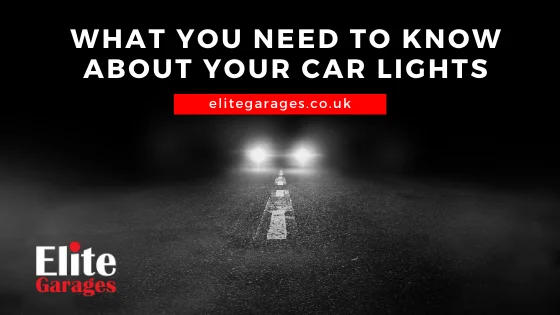
What You Need To Know About Your Car Lights
Although car lights should be an easy topic, you’d be surprised how many people are not fully aware of how to use the right lights at the right time. Some drivers don’t even know about all the car lights on the vehicle and we’d like to make sure you are not one of them.
To pass a driver’s test, everyone must be able to identify car lights and how to properly use them. This is supposed to help drivers use their lights correctly but many forget this important element once they’ve passed. Thing is, not following these rules can put your life in danger and everyone around you.
Car Lights And Winter Driving
Winter driving can be hazardous and it’s made even worse by not maintaining your vehicle and car lights. Visibility is poor in darker and colder weather conditions and bad car lights can really affect your view of the road ahead. If that’s not bad enough, if your lights don’t work properly, other drivers also won’t be able to see you.
Regularly checking the condition of your car’s lights should be a top priority in vehicle maintenance. Headlights should be in the correct position and free from dirt and any build-up of salt. When cleaning your car lights, use a damp cloth to avoid scratching the lenses. A top driving tip is to slightly dip your headlights so you don’t blind oncoming drivers.
Recommended: ‘Winter Driving Tips For Icy Conditions’
Types Of Car Lights
Do you know about your dipped beams, high beams and your sidelights? What about fog lights and hazards? Your vehicle has various lights with very specific functions whether they help improve visibility or act as a signal to other drivers.
Accidents can happen so quickly and it’s even easier when car lights are not used properly, or sometimes not at all. That is why you should know how to recognise the different types of lights and when to use them. Today, we’d like to share some valuable information about your vehicle’s external lights.
Headlights
Cars have dipped beam and full beam headlights, each with their own specific purpose. Headlights allow drivers to see ahead of them in the dark or when visibility is poor. They also signal other motorists that a car is oncoming or present.
Dipped beams provide enough lighting to see ahead and laterally without blinding other road users. They are safe to use at night between half an hour after sunset and half an hour before sunrise. You can also safely use dipped beams during the day at any time when visibility is reduced.
High beams provide intense light distribution with no particular control of glare. You should only use high beams when there are no cars in front of you and not during the day. When overtaking a vehicle at night, switch to your dipped beams.
Rear Lights
Rear lights only produce red light at the rear of the vehicle and light up automatically whenever the headlights are on. While they don’t serve the driver any purpose, it helps other motorists behind you recognise that you are in front and the distance between.
Brake Lights
Located at the back of your car, next to the rear lights are the brake lights. They are used to signal other drivers that you are slowing down or coming to a stop. Brake lights are only activated when you actually apply the brakes so you shouldn’t have any concerns about misusing them. That said, it’s important to make sure you maintain them properly and avoid a blown bulb or fuse.
If you are aware that a brake light is not working properly, you should get it fixed immediately. Not only for safety purposes but it also has other ramifications if pulled over including:
- A verbal warning
- Roadside Prohibition Notice (this gives you 10 days to get it repaired)
- £60 fine and 3 points on your licence
- In a worst-case scenario, your car could be towed away
Indicators
Indicators are located in the front and back of the car, beside the headlights and tail lights. Some cars have them fitted to the side view mirrors. When activated, these lights indicate to other drivers that you will soon make a turn which means you are likely going to slow down as well.
Hazard Lights
Hazard lights are located at the front and the back of your car. When switched on, hazard lights emit a flashing signal to warn other drivers that you might be experiencing a problem. It’s important that you know how to use them correctly and here are a few tips on when to use hazard lights.
- When your car is stationary and causing a temporary obstruction
- Warn other drivers that your vehicle has broken down in a dangerous location that could affect traffic
- Warn drivers on motorways or dual carriageways that there’s a potential hazard ahead
- Switch on hazards if you’ve broken down and stopped on the hard shoulder of the motorway
Did you know?
The only time you are legally allowed to drive with your hazards light on is to warn other drivers on motorways or dual carriageways of any potential hazards.
Daytime Running Lights
Most modern-day cars have daytime running lights which are located in both the front and rear of the car. They generally turn on automatically although in some cars you have the option to switch them off. Their purpose is to make you more visible to other vehicles although many drivers have stated that they are distracting in oncoming cars.
Fog Lights
Fog lights are located near the headlights and generally position quite low. This helps prevent the light from refracting on the fog which could glare back toward you while driving. As the name suggests, these lights help improve visibility when fog appears and they also alert other road users of your presence.
- Use one rear fog light in the UK when fog is present (this is the minimum number of fog lights fitted to all cars)
- Most new cars today have front fog lights as well
- Don’t use fog lights when the weather is clear as you could receive a £30 fine
- Using fog lights in foggy conditions is recommended but not legally required
- You should only use fog lights in foggy conditions when normal headlights are ineffective
Side Lights
Small white lights are located at the front corners of the car which illuminates the licence plate and rear. While they are not nearly as powerful as headlights, they still serve several important functions:
- Sidelights work well when visibility is low but not enough to switch on headlights
- It’s a legal requirement to use sidelights when parking your car at night where the speed limit is 30mph or more
- Sidelights are valuable temporary back-ups in the event that one of your headlight bulbs are blown
- Sidelights indicate to other road users how wide your car is and that you are not a motorcycle
Car Lights And Daytime Driving Rules
While using car lights at night is obviously important, there are also some instances where you should use lights during the day. Here is a brief breakdown for your convenience:
- Brake lights are lit when you press the foot brake but don’t use it continuously in stationary traffic as it can cause unnecessary glare for other drivers
- Headlights and fog lights should be used during the day when visibility is reduced
- Always turn them off lights the moment visibility improves so you don’t blind other road users
- Dipped headlights should be switched on to ensure better visibility in dull weather conditions
- Sidelights (rear licence plate lights) must also be lit between sunset and sunrise
Under the EU rules, since 2011 all new cars are required to have daytime running lights that come on automatically when the engine is started. These will also turn off automatically when headlights or sidelights are lit (these still need to be used as outlined above).
Car Lights And Rules For Driving At Night
Sufficient lighting is vital when driving at night in order to clearly see where you are going and to ensure that others can see you. With that in mind, here are some of the rules for driving at night:
- Always use your headlights at night (half an hour after sunset and half an hour before sunrise)
- Make sure they are dipped in built-up areas, behind other cars or approaching other drivers (this includes pedestrians, cyclists and horse riders)
- When overtaking, always keep your headlights dipped until you are level with the other vehicle and then change to the main beam if necessary
- If someone is dazzling you with their headlights, slow down or stop if necessary
- While you can legally only drive using your sidelights when driving at night under 30mph in a well-lit area, most drivers prefer using dipped headlights for better visibility
Vehicle Safety Checks At Elite Garages
At Elite Garages, we offer you a comprehensive FREE vehicle safety check that can help identify underlying issues before they become serious, dangerous and expensive to repair. In many cases, these checks find minor issues that could cause real concerns at a later stage. They minimise your risk of breaking down, especially in winter, while avoiding potentially fatal situations on the road.
Our technicians are friendly, professional and expertly trained to offer you the best possible advice and service. To ensure you and your family have a safe journey, visit Elite Garages today for a FREE vehicle safety check. For more information about vehicle servicing, MOTs, tyres, batteries, shocks and exhausts among others, please get in touch.
About Us
Opening Times
Saturday : 8:30–4:00
Sunday : closed
More Information
Contact UsCustomer Information Pack
Check MOT Due Date
Free MOT reminder
Careers



